SPARC’s Thermo Scientific™ Dual Spinnaker™ High-Throughput Screening Platform:
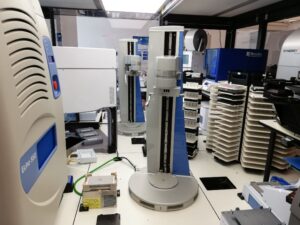
SPARC’s Thermo Scientific™ Dual Spinnaker™ High-Throughput Screening Platform provides a flexible and scalable platform that facilitates reliable and precise microplate handling, enabling researchers to easily automate complex assays and meeting the automation needs for most screening projects. The self-contained unit is equipped with a HEPA filtered enclosure for containment and sample protection, while still providing 360° access. Two central Spinnaker™ gripper robotic arms facilitate plate transfers between all instruments for precise processing and data collection to optimize throughput and performance. The Thermo Scientific Cytomat C10 incubator provides CO2 cell culture storage for up to 242 microplates in a sub-deck incubator with additional capacity for 120 standard random-access ambient temperature plate positions housed in a plate carousel. Drug delivery is performed on the Beckman Echo® 650. The Echo® 650 acoustic dispenser is a tipless, non-contact acoustic dispenser that uses sound energy to dispense precisely sized droplets of reagent or compounds with a resolution of 2.5 nL from any well in a source plate into any well of an assay microplate with exceptional accuracy and precision, offering enormous flexibility and cost saving. The Agilent Bravo liquid handler, with interchangeable 96 and 384 well dispensing heads, tip wash station, and a gripper can be used with disposable tips for accurate pipetting for dispensing from 100 nL to 200 µL. Three incorporated Thermo Multidrop Combi units provide additional efficient bulk reagent delivery. The BioTek Synergy Neo multi-label plate reader enables the use of fluorescent (FI, FP), luminescent, TRF, AlphaScreen, Absorbance/Transmission assays. capabilities.
BioTek Synergy Neo: (integrated into the automation platform)
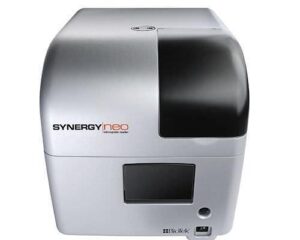 BioTek Synergy Neo multimode microplate reader features patented Hybrid Technology, with independent optical paths that ensure excellent performance in all detection modes. Variable bandwidth quad monochromators, sensitive high transmission filter-based optics, and dual PMTs provide ultrafast measurements. Barcode-labeled filter cubes to streamline workflows and limit errors. Powerful Gen5 software provides complete reader control and powerful data analysis.
BioTek Synergy Neo multimode microplate reader features patented Hybrid Technology, with independent optical paths that ensure excellent performance in all detection modes. Variable bandwidth quad monochromators, sensitive high transmission filter-based optics, and dual PMTs provide ultrafast measurements. Barcode-labeled filter cubes to streamline workflows and limit errors. Powerful Gen5 software provides complete reader control and powerful data analysis.
- Modularity allows a wide range of screening laboratories, pharmaceutical, biotechnology, and academic facilities to achieve fast, high-performance multimode microplate detection
- With its proprietary hybrid monochromator and filter optics, Synergy Neo delivers both flexibility and performance for many applications
- Variable bandwidth settings enable increased sensitivity and lower limits of detection or increased specificity when multiple signals are present, reducing signal cross-talk
- Dual PMTs take two measurements simultaneously and deliver faster results than conventional systems. The fast PMT detection is ideal for FP, FRET, TR-FRET, BRET, and other ratiometric assays
- A100-mW laser for Alpha assay provides increased sensitivity and fast reading speeds
Thermo™ Scientific Cellomics CX7 Lzr Pro:
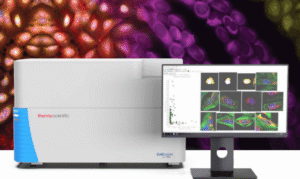 The CX7 Lzr Pro, known for its robust imaging and integrated informatics solutions, offers complete live-cell quantitative kinetic imaging. Scientists now have the ability to not only image live cells, but to keep those cells alive for both short- and long-term experiments in a controlled environment similar to that of a tissue culture incubator.
The CX7 Lzr Pro, known for its robust imaging and integrated informatics solutions, offers complete live-cell quantitative kinetic imaging. Scientists now have the ability to not only image live cells, but to keep those cells alive for both short- and long-term experiments in a controlled environment similar to that of a tissue culture incubator.
The CX7 from Thermo Scientific is equipped with environmental controls and automated robotic liquid handling for microscopy of live cells. It is capable of resolving spatially and temporally separated fluorescent labels to quantitatively measure multiple features simultaneously to determine the effects of gene over-expression, knock-down or small molecules have on cellular phenotypes.
- Sub-second High Resolution Cellular and Sub-Cellular Imaging enables users to monitor and analyze multiple, individual cells with sub-cellular resolution. Data reveals heterogeneity of kinetic responses and enables researchers to make better decisions by observing correlations that are not revealed in well-average responses.
- Kinetic Assay Scheduling Software permits fully automated, unattended execution of complex, live cell experimental protocols involving data acquisition, processing and analysis, as well as pipetting activities for increased productivity.
- Integrated Liquid Handling System provides fully functional liquid handling for compound and reagent delivery, mixing and cell washing during live cell experiments.
- Onboard Environmental Control enables live cell experiments by maintaining precise physiological conditions throughout the assay time course, resulting in more biologically meaningful results.
- Flexible Optical System for both brightfield and fluorescent imaging with automated filters and 1.25X through 40X objectives provides flexibility for a wide variety of fluorescent reporters and dyes for ratio metric imaging. Compatibility with 6 through 384 well plates.
- Proprietary BioApplications reduce assay development time by providing researchers with “plug and play” software modules and the flexibility to adjust assay parameters for measurement of a wide range of biological outputs.
Integration of the CX7 Lzr Pro with our Thermo Scientific™ Dual Spinnaker™ High-Throughput Screening Platform via Momentum enables fully automated imaging of samples 24/7 for drug screens.
Molecular Devices ImageXpress Micro Confocal System (IXMC):
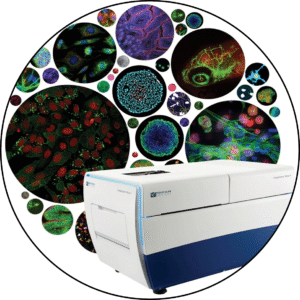
Our ImageXpress Micro Confocal System enables automated high throughput image based screening and detailed analysis of 3D structures such as organoids, spheroids, cell clusters, zebrafish embryos, C. elegans, Drosophila eggs and larvae. The IXMC permits reconstruction of 3D structures by rapidly collecting a stack of crisp images in the Z-plan images for subsequent 3D analysis. The IXMC can also acquire images from a variety of specialized multi-well formats developed for 3D assays, including round bottom, trans-well and hanging drop plates, which facilitate consistent and controllable formation of 3D organoids, spheroids and cell aggregates. The IXMC can also image through specialized matrices used for the formation and differentiation of organoids. The high-quantum efficiency 16-bit scientific CMOS sensor captures a field of view that is 3x larger than the industry standard such that large multicellular objects and whole organisms. The onboard liquid handling fluidics utilize a single channel pipettor to dispense reagents, perform media channels and add chemical stimulants to cells while simultaneously imaging for real time measurement and analysis of dynamic biological processes. MetaXpress Software provides turnkey application modules to address hundreds of common analysis routines, such as micronucleus detection, neurite outgrowth, angiogenesis tube formation, mitotic index, cell cycle analysis, proliferation, cell health (viability/toxicity, apoptosis, necrosis) and translocation events. The custom module editor provides a flexible toolbox for the 3D analysis and quantification of parameters such as volumes, intensities and distances.
Beckman Echo 650 Acoustic Liquid Handler:
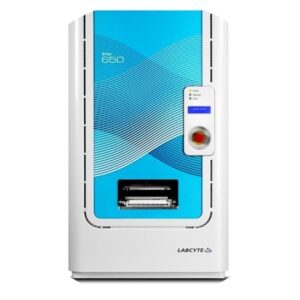 The Echo liquid handlers have revolutionized compound management and high-throughput screening through the use of acoustic energy. Echo screening models provide powerful benefits:
The Echo liquid handlers have revolutionized compound management and high-throughput screening through the use of acoustic energy. Echo screening models provide powerful benefits:
- Tipless transfer, resulting in dramatic cost savings
- Accurate, precise movement of nanoliter-scale quantities, enabling assay miniaturization and further reducing costs
- Elimination of cross-contamination, carryover or leachates
- Better results through direct dilution of compounds, an improvement over serial dilution methods
- Improved information about sample integrity and improved transfer quality through measurement of DMSO hydration level
Watch a video that describes how the Echo work
Live-Cell Imaging and Analysis System: Incucyte® S3:
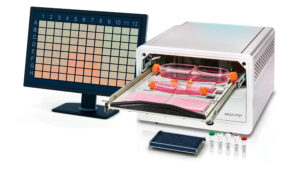 With the Incucyte® S3 Live-Cell Analysis System, take your research further with automatic acquisition and analysis of cells in a physiologically relevant environment. See more information in every sample and explore more applications – from cell health to complex functional assays – through utilization of up to two total fluorescence and HD phase imaging channels simultaneously.
With the Incucyte® S3 Live-Cell Analysis System, take your research further with automatic acquisition and analysis of cells in a physiologically relevant environment. See more information in every sample and explore more applications – from cell health to complex functional assays – through utilization of up to two total fluorescence and HD phase imaging channels simultaneously.
Key Features:
- Robust application suite
- Multi-user, multi-application support through remote network capability and unlimited user licenses
- Two-color Green|Red plus HD phase contrast imaging
- 4X, 10X, 20X objectives on an automated turret
- Support for three interchangeable vessel trays and over 700 vessels, compatible with flask, dishes, slides and microplates – up to six microplates in parallel.
Analyze even the most sensitive living cells around the clock for days, weeks or months. Never miss powerful insights again with the Incucyte® S3 Live-Cell Analysis System and associated reagents, consumables and software!
Molecular Devices FLIPR (Fluorometric Imaging Plate Reader):
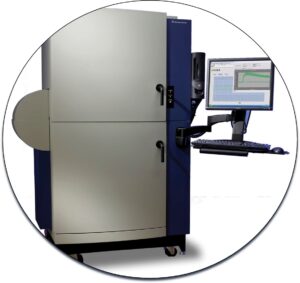 SPARC’s FLIPR Tetra® High-Throughput Cellular Screening System provides an automated solution for identifying early leads and for evaluating drug efficacy and toxicity. Simultaneous pipette and read function supports an incredible range of fast kinetic cellular assays including calcium, cardiotoxicity, potassium, and membrane potential.
SPARC’s FLIPR Tetra® High-Throughput Cellular Screening System provides an automated solution for identifying early leads and for evaluating drug efficacy and toxicity. Simultaneous pipette and read function supports an incredible range of fast kinetic cellular assays including calcium, cardiotoxicity, potassium, and membrane potential.
Unionbiometrica BioSorter
Unique to SPARC DD is the incorporation of our Union Biometrica BioSorter large particle flow cytometer. It is the only available flow system that can sort a broad range of diverse fragile multicellular structures ranging in size from 10-1500 microns such as organoids, embryonic stem cell clusters, Drosophila eggs/embryos and larvae, zebrafish embryos and C. elegans for subsequent downstream applications. Sorting is achieved by determining object size by measurement using a light-loss detector and optical density. or fluorescence intensity of markers in 3 channels.
BioSorter:
 The BioSorter® is a continuous flow system capable of analyzing, sorting and dispensing objects ranging in size from 10 to 1,500 µm. Relative axial size is measured by an axial light-loss detector and optical density is determined by the total integrated signal of the light blocked. The fluorescence intensity can be simultaneously measured at three different wavelengths as determined by the excitation and emission filters in the system.
The BioSorter® is a continuous flow system capable of analyzing, sorting and dispensing objects ranging in size from 10 to 1,500 µm. Relative axial size is measured by an axial light-loss detector and optical density is determined by the total integrated signal of the light blocked. The fluorescence intensity can be simultaneously measured at three different wavelengths as determined by the excitation and emission filters in the system.
The system is controlled by a Windows® based workstation utilizing FlowPilot™ or FlowPilot-Pro™ software with real-time data acquisition via on-board customized electronics. Additional copies of the software are available for off-line post-run data analysis.
Using FlowPilot software, real-time analysis of the measured parameters is used to make sort decisions. Only those objects meeting the user-selected sort criteria are dispensed into multiwell plates, tubes or stationary receptacles. Those objects not meeting the sort criteria are gently deflected to a separate container where they may be recovered, unharmed and viable.
Instrument parameters and sample data are displayed on a large format LCD display; a second monitor is optional.
Each BioSorter system includes a fluidics caddy which organizes the reservoirs, waste container and pumps into a single, roll-around module.
Samples are introduced via a 50 ml conical tube (40 ml working volume) with suspended stirrer. For larger samples we offer optional 750ml and 1.5L stirred cups. For handling extremely delicate samples (adipocytes, plant protoplasts, etc.) and for samples that tend to either float or sink in a standard sample cup, a flow-through 5 or 10 ml rotating sample introduction chamber with integrated agitator is also optional.
An X-Y-Z stage allows dispensing into 24-, 48-, 96-, or 384-well multiwell plates, tubes and bulk receptacles. The z-direction allows adjustment for different height plates (deep well plates) and tubes.
High Throughput Screening features include liquid level sensors as well as automatic sample and pressure controls for walk-away operation.
Bravo Automated Liquid Handling Platform:
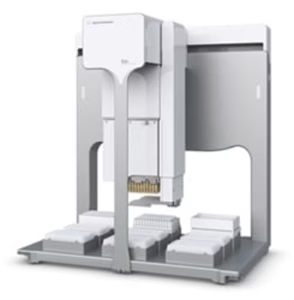 Agilent Bravo Automated Liquid Handling Platform is both versatile and precise, loaded into a small, compact footprint. It is the fastest, most versatile liquid-handling system available to perform pipetting in both 96- and 384-well plate.
Agilent Bravo Automated Liquid Handling Platform is both versatile and precise, loaded into a small, compact footprint. It is the fastest, most versatile liquid-handling system available to perform pipetting in both 96- and 384-well plate.- Providing speed and precision, Agilent’s automated liquid handling solutions cover a wide range of applications, utilizing the most advanced technologies to provide the performance and reliability that today’s scientists demand.


